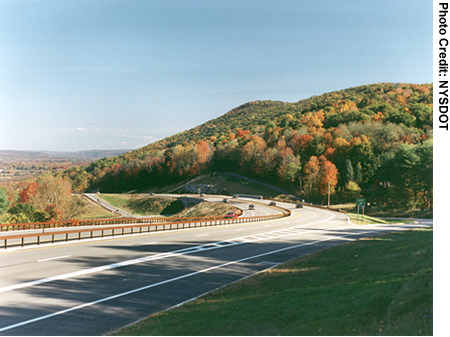U.S. Department of Transportation
Federal Highway Administration
1200 New Jersey Avenue, SE
Washington, DC 20590
202-366-4000
Focus
| Accelerating Infrastructure Innovations |
Publication Number: FHWA-HRT-10-016
Date: August 2010
How healthy is your pavement network? Use the Federal Highway Administration's (FHWA) new Pavement Health Track (PHT) Analysis Tool to determine the health of your pavement network in terms of the pavement's remaining service life (RSL). The PHT Analysis Tool uses pavement performance models developed by FHWA for the Highway Economic Requirements System (HERS) and the National Pavement Cost Models. These pavement performance models are simplified versions of the models and procedures used in the American Association of State Highway and Transportation Officials' Mechanistic-Empirical Pavement Design Guide.
The PHT Analysis Tool was developed for FHWA by Battelle and Applied Research Associates, using an engineering analysis software interface tool architecture created by Battelle. "The new PHT tool allows users to determine pavement health in terms of pavement remaining service life based on rideability and pavement distresses," says Nastaran Saadatmand of FHWA's Office of Asset Management. Pavement health can be determined for different pavement types under various conditions such as climate or whether it is in a rural or urban environment. "The PHT tool has a range of applications, including individual projects, corridors within a State or that cross State lines, and highway networks," says Saadatmand.

Use FHWA's new Pavement Health Track Analysis Tool
to determine the health of your pavement network.
For the purpose of the tool, RSL is defined as the life of the pavement from the present until it no longer provides an acceptable level of service. RSL can be reported as both the weighted average RSL of all distresses or as the RSL for one particular distress for a given section of pavement or the entire network.
The software requires inputs from the Highway Performance Monitoring System 2010 pavement data, or a State can use data from its pavement management system database. The program provides an option for inputs on material properties, climate, and loading to predict the future remaining service life of the pavement. If the data is not available, the program contains a compiled data set that uses data from such sources as the FHWA Long-Term Pavement Performance program and National Climate Data Center databases as default inputs. This compiled data set meets the needs of the RSL predictive models. Users must also specify criteria such as thresholds for distress and deficiency levels to reflect their agency's policies regarding the conditions that trigger maintenance and rehabilitation of rigid, flexible, and composite pavements.
The software offers a library of charts, geographic information system maps, and reports that can be customized by the user. "The charts and graphs will help users and agency decisionmakers visualize the analysis results and more effectively use the information," says Saadatmand. A "wizard" tool takes the user step by step through the various options available for each type of report, chart, and map and provides data filtering, sorting, and aggregation. The primary data outputs will be the number of years until the terminal values for various distresses and the International Roughness Index (IRI) have been reached and the predicted distresses/IRI at the end of the weighted average RSL.
A modular design allows for future expansion of the software's capabilities, including adding such features as the ability to develop and display the bridge health index for a particular corridor and to estimate pavement asset values, the impact of various maintenance and rehabilitation plans on RSL, and reconstruction needs. Additional future capabilities could include the ability to detect uneven distribution of RSL, integrate benefit and cost models from HERS, and incorporate State-specific pavement models or calibrated pavement performance coefficients.
The PHT Analysis Tool will be available this month from FHWA. A training session will be held in October for FHWA and State participants. To obtain a copy of the PHT Analysis Tool or for more information on the training session, contact Nastaran Saadatmand at FHWA, 202-366-1337 (email: nastaran.saadatmand@fhwa.dot.gov)